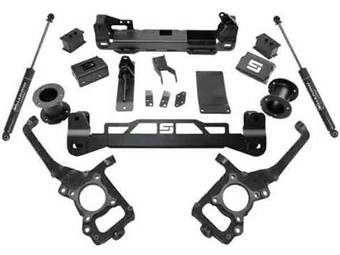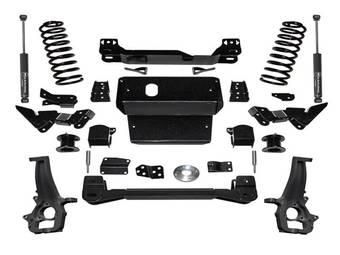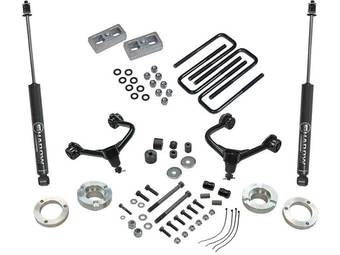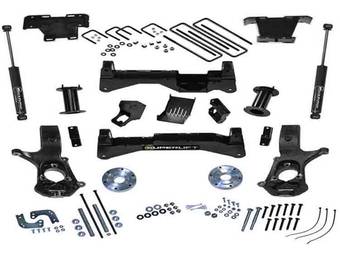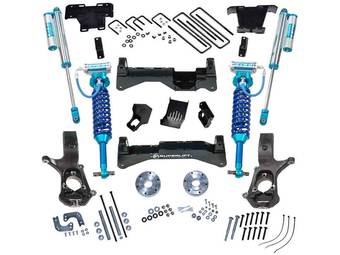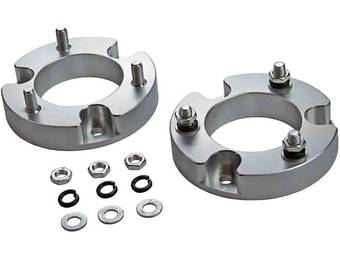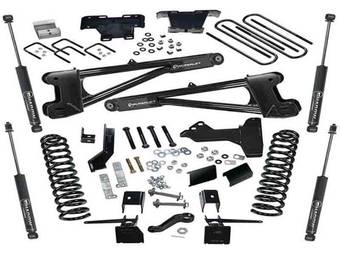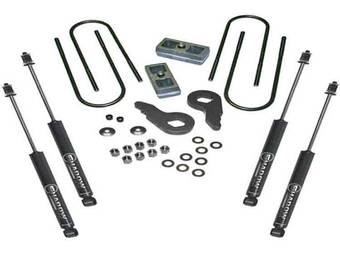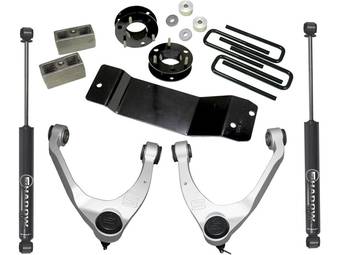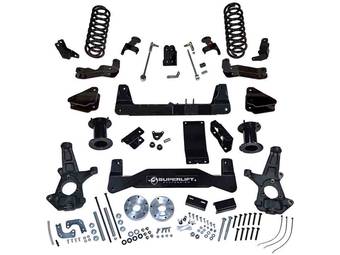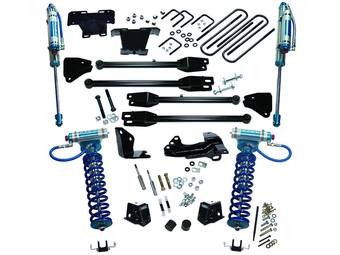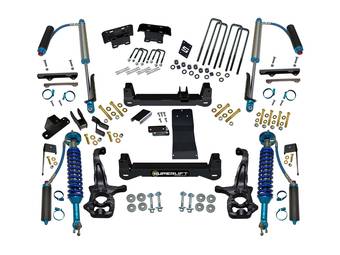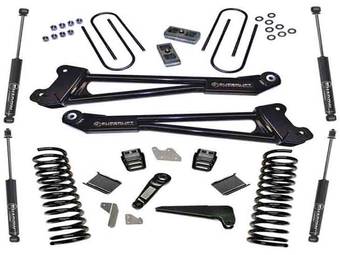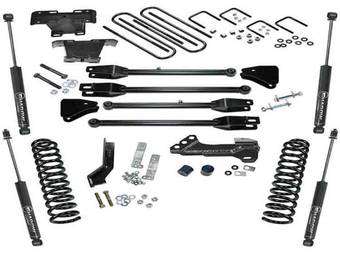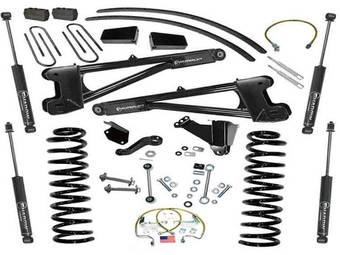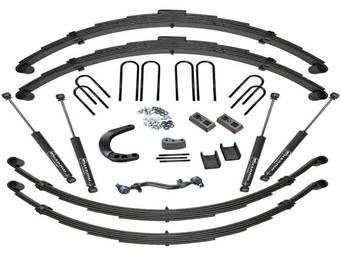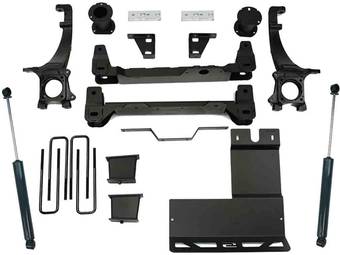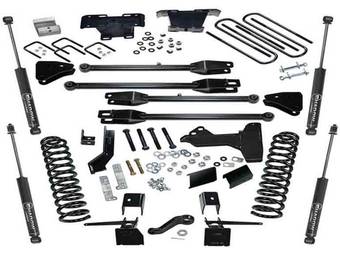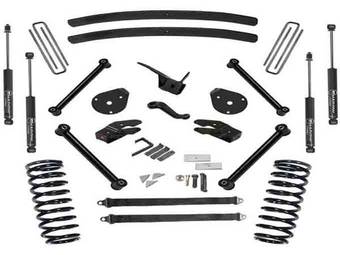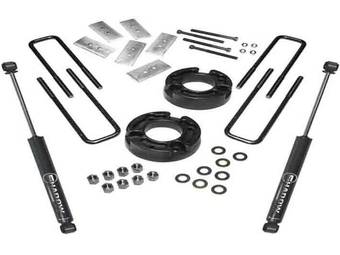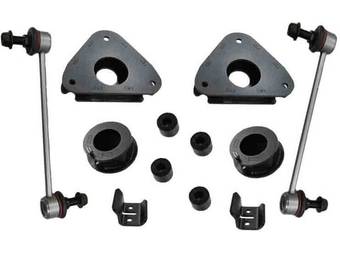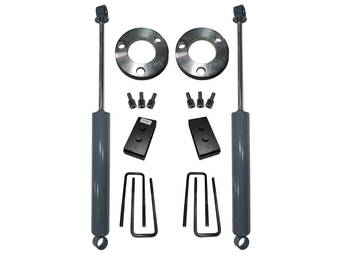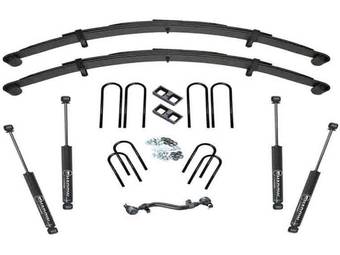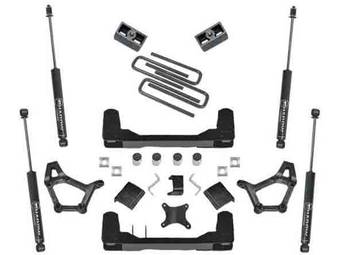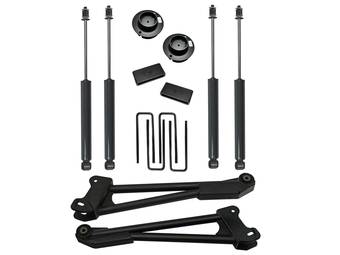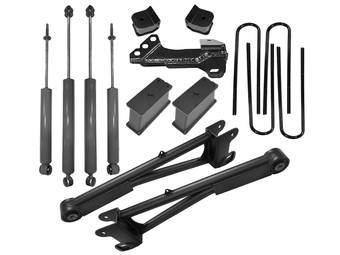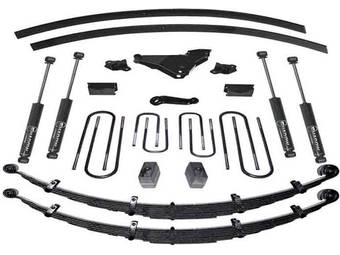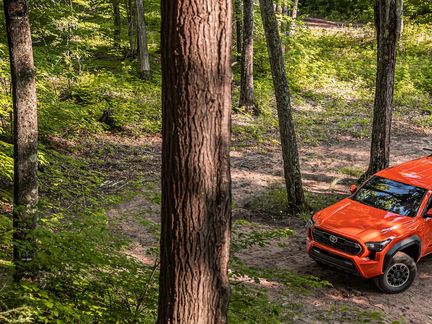Free Shipping on Orders Over $100
"Super-Speak" Suspension Terms and Definitions
Updated on Oct 22, 2025
Articulation
Is how well each axle, or each wheel will travel and "twist-up" when traversing an extremely off-camber obstacle. When off-roading, you want as much controlled suspension articulation as possible to keep all tires on the ground and getting traction. As suspension manufacturers, we search for the right balance of off-road articulation and on-road stability.
Body Roll
Is most noticeable when turning at speed. One side of the suspension compresses and the opposite side lifts. If excessive, it is a symptom of one or more of these factors: insufficient sway bar diameter, "too light" spring rates, incorrect shock absorber valving.
Bump Steer
Is when a vehicle darts or wanders, especially when operated on a less than ideal driving surface; the tires "steer" themselves without any input from the steering wheel. Bump steer can be caused by a number of alignment related issues, but the primary culprit is an insufficient caster.
Bump-Stops
Are also commonly termed "compression travel stops" and "jounce stops". These components cushion the suspension "bottoming-out" process to prevent vehicle suspension damage and/or occupant spine damage. In a lift system, the factory bump stops are normally relocated or replaced.
C-Bushings
Are the bushings located between the radius arms and front axle on 1966 to 1979 Ford Broncos and ½-Ton pickups. Factory C-Bushings are formed rubber pieces, prone to dry rot and shift out of place. Superlift C-Bushings are made of Polyurethane material and feature formed "lips" to keep them in place, plus they are available in different offsets to improve caster angle.
Camber Angle
Is the inward (negative), or outwards(positive) tilt of the front tires as viewed from the front. Improper camber makes the tire wear on one edge, and causes the vehicle to pull to the side that has the most positive
Caster Angle
Is the fore or aft slope of the steering axis. The steering axis is a line drawn through the knuckle’s upper and lower ball joints. Positive caster is when the bottom of the steering axis line is in front of the tire’s contact patch. Factory alignment specs for basically all vehicles call for a certain degree of positive caster (shown). This ensures good stability, helps maintain straight-ahead direction and promotes steering wheel self-centering.
Centerlink
A piece of steering linkage that connects the pitman and idler arms, commonly found on IFS vehicles that have upper and lower control arms. A tie rod connects to each end of the centerlink. On most lifted trucks, the factory centerlink is either relocated or replaced by a "dropped" centerlink.
Chromoly
Chromoly is an abbreviated term for very strong steel that contains chromium and molybdenum.
CNC Machine
CNC is the abbreviation for Computer Numerical Control. Therefore, a CNC machine is computer controlled to make very accurate and repeatable parts.
Coilover
"Coilover" is short for "coil spring over shock". It consists of a shock absorber with a coil spring encircling it. The shock absorber and spring are assembled as a unit prior to installation and are replaced as a unit when the shock absorber has leaked. This provides damping without torsional loads. Some coilovers allow adjustment of ride height and preload, using a simple threaded spring perch similar to a nut. The SUPERLIFT Edition KING coilovers have a more advanced adjustable coilover systems that use a threaded shock body, along with an adjustable lower mount for ride height adjustment, while an adjustment knob is used to adjust damping. Stiffness is changed by switching the spring for one with a different spring rate.
Compression Travel
The measurement of the amount the suspension will compress before it bottoms-out against its bump-stops.
Control Arms
Also called "A-arms" because if their shape, are found on all IFS suspensions listed in the catalog except for the Ford Twin Traction Beam (TTB). There is one upper and one lower arm per side. They have a balljoint on the outboard end and connect to the frame on the inboard end.
CSS
Acronym for SUPERLIFT’s Centerlink Stabilizing System. Unless stabilized, a dropped centerlink will pivot fore and aft when turning force is applied. This causes accelerated pitman and idler arm wear, plus less than ideal steering "feel" and response. Depending on application, the CSS uses one or two links to tie the centerlink to a crossmember and prevent this undesired movement.
Curb Weight
Is how much the vehicle weighs "wet" (with fluids, fuel, etc.) but without passengers, a load, etc.
CV Axle
Acronym for Constant Velocity axle. With a control arm style IFS, these are the rubber or plastic booted axle shaft assemblies (one per side) that bolt to the differential hosting flange on the inboard end, and mate to the hub/knuckle on the outboard end.
CV Style Driveshaft
The driveshaft offered by SUPERLIFT are actually Dual Cardan style shafts, although everyone refers to them as CV (Constant Velocity) driveshafts. This type shaft is ideal for high operating angle applications, and/or when the vehicle has a considerable amount of suspension extension travel.
Top-Selling Lift Kits and Accessories
Check out some of the top rated products that are field-tested and tough enough for anything your truck, Jeep, or SUV can throw at them.
DOM
Acronym for Drawn Over Mandrel. The term specifies a type of tubular steel that has exceptional strength, forming and welding characteristics.
DOT
Acronym for (Federal) Department of Transportation
Drag Link
A piece of steering linkage that connects to a pitman are at it upper end, and a tie rod or knuckle at its lower end. On lifted vehicles, sometimes the factory drag link is replaced by a "dropped" drag link to reduce drag link angle. Adjustable drag links are offered to restore equal turning radius, and left/right steering wheel "center".
Drivability
The sum of the vehicle’s driving traits and mannerisms. Handling, steering traits and ride quality are the major categories that influence drivability.
Driveshaft Angle
The angle of the drive shaft in relation to the pinion yoke (at the differential) or the output yoke (at the transfer case). Driveline vibration, bind-free operation and shaft length are influenced by driveshaft angle.
ESC
Acronym for Electronic Stability Control. ESC is the generic term for an active vehicle safety system that uses multiple sensors to control braking, acceleration or deceleration at each wheel when traction or loss of control is detected. Other trade names include Electronic Stability Program (Chrysler), and StabiliTrak (GM).
Extension Travel
A measurement of the amount the suspension will extend before it tops-out against its travel limiters.
Four-Link Suspension
This suspension type uses two upper and two lower link-arms to connect the solid axle (front or rear) to the frame. The Jeep TJ utilizes a typical 4-link system.
GVWR
Acronym for Gross Vehicle Weight Rating. This information is provided by the vehicle manufacturer and is located on a tag generally found on the driver side door jamb. It tells you how much total weight, including occupants, fuel, load, etc., the vehicle is rated to carry.
Idler Arm
An idler arm is found on IFS vehicles that have a centerlink. The idler arm supports one end of the centerlink while the pitman arm supports the other.
IFS
Acronym for Independent Front Suspension. With this type of suspension, the wheels travel independently of each other. The IFS covered in this website are either control arm types or Ford Twin Traction Beam (TTB).
Jam Nuts
This part is used to secure or "jam" a nut and prevent loosening.
Knuckle (Steering)
Steering knuckles are castings (iron or aluminum) that attach to the outboard ends of the front axle and pivot via upper and lower ball joints. Replacement knuckles are used on lifted IFS vehicles when the lower control arms are relocated, but the upper control arms are not. SUPERLIFT knuckles are domestically produced and machined in-house by SUPERLIFT.
Lift Kit
A suspension lift or lift kit is a modification, often done by Jeep, truck, SUV and off-road enthusiasts to raise the ride height of their vehicle. Lift kits help accommodate larger tire and wheel combos and improve off-road performance. Each manufactured vehicle usually requires a specific lift kit, and the types of kits vary based on the type of drivetrain that the vehicle has. Kits can be as simple as replacement leaf springs, coil spring/strut spacers, and extended shocks; to replacement control arms, drop down brackets, lift spindles and other related components. Suspension lifts could also impact other factors, such as drive shaft length, steering geometry and brake lines.
Leveling Kit
Leveling Kits are the perfect solution for anyone wanting an economical and easy way to eliminate the factory nose-down rake on virtually all late-model trucks and SUVs. Leveling kits are also the ticket for people wanting to make room for little larger tire and wheel package. Leveling kits work with factory suspension components to achieve modest ride height gains without a lot of hassle. These systems are simple and effective, with installation times normally around only two hours. The leveling kits provide 1-1/2" to 3" of lift height depending on the application via components that are precision-engineered and easy to install.
Long Arm Suspension
On a 4-link or radius arm suspension, when the factory links or arms are replaced with longer units, this is termed a long arm suspension conversion. Longer arms result in less geometry change, as the suspension travels, which improves drivability, plus they allow more bind-free suspension travel.
Military Wrap
Featured in some leaf spring designs, the second leaf plate wraps around the spring eye (called the main leaf) to form a double-wrap. This design element transmits less stress to the main leaf during extreme articulation. It also lessens the odds of spring separation in case of main leaf failure and provides greater strength, support, and durability as a whole.
OEM
Acronym for Original Equipment Manufacturer. For example Ford, GM, Chrysler, etc.
Pitman Arm
A pitman arm connects the steering box to the truck’s steering linkage. This steering component splines onto the steering sector output shaft. The opposite end connects to a drag link or centerlink, depending on steering system type. With a "dropped" pitman arm, the drag link attachment point is moved down to corrects steering geometry by reducing the drag-link angle in relation to the tie rods on lifted 4x4s
Pre-set Coil Springs
Pre-setting involves fully compressing the coil spring (so that the coil wraps are actually touching each other) in the manufacturing process. This reduces the amount of coil sag and extends coil service life.
Progressive Rate Coils
Most coil springs have rates that are constant; if it takes 400 pounds to compress the spring the first one inch, another 400 pounds will compress it the second inch, and so on. With a progressive rate coil, spring rate for the initial couple inches of compression is less than the spring rate for the remainder of compression. This improves your "Sunday drive" ride quality, yet rate can still accommodate more aggressive driving. On progressive rate springs, the first few coil wraps are more closely spaced than the remaining coils or the entire spring is slightly conical (cone-like) in shape.
Radius Arm
The radius arms (one per side) run basically parallel to the frame rails. They locate the front axle housing and prevent fore and aft axle movement. Common vehicles factory equipped with radius arms are 1966-79 Fords with coil spring / solid axle suspension, 1980-96 Fords with coil spring TTB, and 2005 and newer Super Duty. Caster angle must be addressed when lifting vehicles with radius arms.
Roll and Yaw
The problem exists on lifted vehicles that have incorrect track bar length and/or severe track bar angle. When lifted past a certain point, the track bar should be lengthened or binding occurs as the suspension travels. If unaddressed, the frame and axle housing will continuously "tug" against each other. This is most noticeable when the vehicle is being driven in a straight line, going through highway dips at speed. The sensation compares to the side-to-side oscillations of a boat. A certain amount of "steering wheel kick" normally accompanies roll and yaw.
Solid Axle
A one-piece axle housing design that has rigid axle tubes all the way out to the knuckles. Examples of vehicles with solid front axles are 1966-79 Fords and 1969-87 GM trucks.
Spring Rate
A measurement of force (in pounds) required to compress a spring a given distance (in inches). Be careful when comparing rates since all manufacturers do not use the same measuring procedures.
Steering Arm
This forged steel component bolts to the front axle knuckle. Its opposite end attaches to the drag link. A raised steering arm is taller to reduce drag link angle. Steering blocks can also be used to alleviate drag link angle.
Steering Block
A steering block relieves drag link angle by positioning between the factory steering arm and steering knuckle.
Steering Wheel Kick
This malady is most noticeable when you are driving in a straight line and the suspension compresses, like when going through a highway dip at speed. The steering wheel will move slightly, but the vehicle continues to track straight ahead. If the vehicle has a track bar, the problem is related to incorrect track bar length (too short) and/or incorrect phasing. Incorrect phasing exists when the track bar arc-of-movement is not in phase with the drag link arc-of-movement. Incorrect phasing can result when a dropped pitman arm is used, but the track bar is not properly relocated. A certain amount of phasing miss-match is acceptable, but at some point "kick" will occur.
Strut Assembly
Found on many late-model IFS vehicles, a strut assembly consists of a coil spring that attaches to a strut body (shock absorber). Coilover shocks are used to replace struts when more coil rate and height adjustability is desired.
Stud Bind
Occurs when a tapered stud, normally a tie rod or track bar end, over-extends its pivot capability. This is a byproduct of excessive operating angles.
Suspension Travel
The amount of available wheel travel from full compression to full extension.
Sway Bar, Sway Bar Links
Also referred to as a stabilizer bar or an anti-sway bar. The sway bar assembly consists of a U-shaped tubular body that spans the width of the vehicle frame, and two links (one per side) that connect the body to an anchor point on the axle or control arm. Generally, at a certain lift height, either the bar body is relocated, or longer links are used, to prevent sway bar preload.
Sway Bar Pre-Load
As lift height increases the sway bar body pivots and begins to pre-load. This pre-load puts extra stress on the links, which limits additional suspension travel and flexibility. Proper bar geometry is restored by relocating the body or by using longer links.
T-Case
Short for a transfer case. A device usually attached directly to the transmission. The transfer case is a gearbox that splits engine power to the front and rear axles. You can select two-wheel-drive or four-wheel-drive high or low range with most transfer cases.
Tie Rod
A section of steering linkage. All outer tie rod ends attach directly to the knuckle.
Toe Angle
A steering geometry term, this refers to the difference in track width measurements taken at the front side and rear side of the front tires. If the measurement is less at the front, it is termed Toe-In. If the measurement is less at the rear, it is termed Toe-Out.
Track Width
The distance between two wheels that are on the same axle, as measured from the center-points of left- and right-side wheels.
Track Bar
Found on basically all coil spring equipped vehicles that have solid axles, and most later-model leaf spring equipped vehicles. The bar helps locate and stabilize the body/frame, in relation to the axle housing. Generally, when lift exceeds 2", the bar must be relocated and/or replaced with a longer, adjustable unit.
Traction Control
Most modern 4x4 vehicles will have some level of traction control. It could have a simple on/off setting, or a complex system with multiple settings programmed for different traction situations. No matter the system, traction control uses either the brakes and/or the 4x4 mechanicals to limit wheel slip and ensuring torque is being transferred from the tire to the trail... Since there are so many kinds of traction control systems, we encourage you to read up on yours and its many settings in your owner's manual.
TTB
Acronym for Twin Traction Beam, Ford's Independent Front Suspension system found on most 1980 to 1996 models.
Turning Radius
A measurement of the distance required to turn a vehicle in a full circle.
Wheel Base
Distance from the center of a vehicle's front wheel to the center of its rear wheel on the same side of the vehicle. Vehicles with longer wheelbases offer a smoother ride, but shorter wheelbases prove advantageous on uneven trails because the center of the vehicle is less likely to become stuck in a high-centered position.
Wrap-Up
Referred to as both rear spring and rear axle wrap-up. As power is applied, torque load causes the rear pinion to pivot upward. Once this load reaches a certain point the leaf springs begin to deform, and wheel-hop is induced. The "fix" is to increase spring strength or to reduce leverage by decreasing lift block height.
VIDEO: RealTruck Explained - Do Stock Shocks Work With a Lifted Truck?
Shop Now
RealTruck is your home for the best products to outfit your build for unforgettable adventures.
Bed Liners and Mats | Fender Flares | Exhausts and Mufflers | Suspension
See More Guide Articles Here...
- …
Join over 2 million RealTruck people
Get exclusive savings, insider information, and the latest RealTruck articles sent straight to your inbox.
